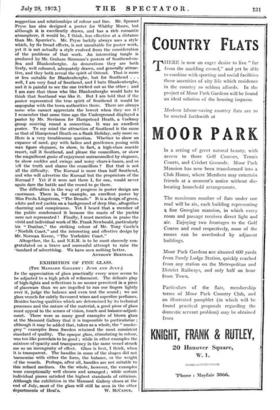MATERIAL REVIEWS.
SOME SPIRITED RAILWAY POSTERS.
Tan London and North-Eastern Railway have inherited from the late N.E.R. the realization that beauty is not necessarily bad business. They are not the first firm to realize it, but so surely is such an idea caviare to the general, that there is still an element of bravery in their acting upon it. They have, however, acted upon it, and the result, which was displayed at an exhibition held for two or three days at the Board Room, King's Cross, although not completely satisfactory, was so far admirable that we can earnestly wish more power to their arm. Not only must their success " be as effectual as the trumpet blast which so disastrously affected the walls of Jericho," to quote from Mr. Collins Baker's preface to the catalogue, but it must also rebuild that city within easy reach of Beauty. In fact, this exhibition as a whole overthrows the bad old posters, and sets up new and better ones. I say " as a whole " because there are one or two curious lapses, bits of the old wall left standing.; "Loch Lomond," for example, with its ice-cream mountain and oily texture, and the dull, familiar seasides of Mr. Fred Taylor, R.I. If you had seen these posters on a hoarding you would not have looked at them. But it is ungracious to select the feeble for remark when there is a heavy preponderance of the strong.
I was most delighted with three posters by Mr. Steven Spurrier, R.O.I., " Yorkshire Fisherman," " Northumberland Fishwife " and" Whitby Moors." Mr. Spurrier has an excellent technique for poster work. bold and simple, yet capable of subtle suggestion and relationships of colour and line. Air. Spenser Pryse has also designed a poster for Whitby Moors, but although it is excellently drawn, and has a rich romantic atmosphere, it would be, I think, less effective at a distance than Mr. Spurrier's. Mr. Pryse luckily always uses a style which, by its broad effects, is not unsuitable for poster work, yet it is not actually a style evolved from the consideration of the problems of that work. An interesting tangle is produced by Mr. Graham Simmons's posters of Southend-on- Sea and Blankenberghe. As decorations they are both lively, well coloured, adequately drawn, and generally attrac- tive, and they both reveal the spirit of Ostend. That is more or less suitable for Blankenberghe, but for Southend . . . well, I am very fond of Southend, and I hate Blankcnberghe, and it is painful to see the one tricked out as the other ; and I am sure that those who like Blankenberghe would hate to think that Southend was like it. But I am told that if the poster represented the true spirit of Southend it would be unpopular with the town authorities there. There are always some who cannot appreciate the lowest when they see it 1 I remember that some time ago the Underground displayed a poster by Mr. Nevinson for Hampstead Heath, a Cockney group centring round a concertina. It was an excellent poster. To my mind the attraction of Southend is the same as that of Hampstead Heath on a•Bank Holiday, only more so. Here is a very troublesome question. Whether to show an expanse of sand, gay with ladies and gentlemen posing with wax figure elegance, to show, in fact, a high-class seaside resort, call it Southend, and please the councillors, or show the magnificent gusto of enjoyment untrammelled by elegance, to show cockles and swings and noisy chars-it-bancs, and so tell the truth and shame the councillors ? But that is not all the difficulty. The Kursaal is more than half Southend, and who will advertise the Kursaal but the proprietors of the Kursaal ? Yet if it were not there I, for one, would never again dare the battle and the crowd to go there.
The difficulties in the way of progress in poster design are enormous. There is, for example, an excellent poster by Miss Freda Lingstrom, "The Broads." It is a design of green, white and red yachts on a background of deep blue, altogether charming and conspicuous. Yet I heard that a member of the public condemned it because the masts of the yachts were not represented ! Finally, I must mention in praise the vivid and individual work of Mr. Frank Newbould, particularly his " Dunbar," the striking colour of Mr. Tony Castle's
Norfolk Coast," and the interesting and effective design by Mr. Norman Keene, " The Yorkshire Coast."
Altogether, the L. and N.E.R. is to be most sincerely con- gratulated on a brave and successful attempt to raise the 'tandard of advertising. We have seen nothing better.
ANTHONY BERTRAM.







































 Previous page
Previous page